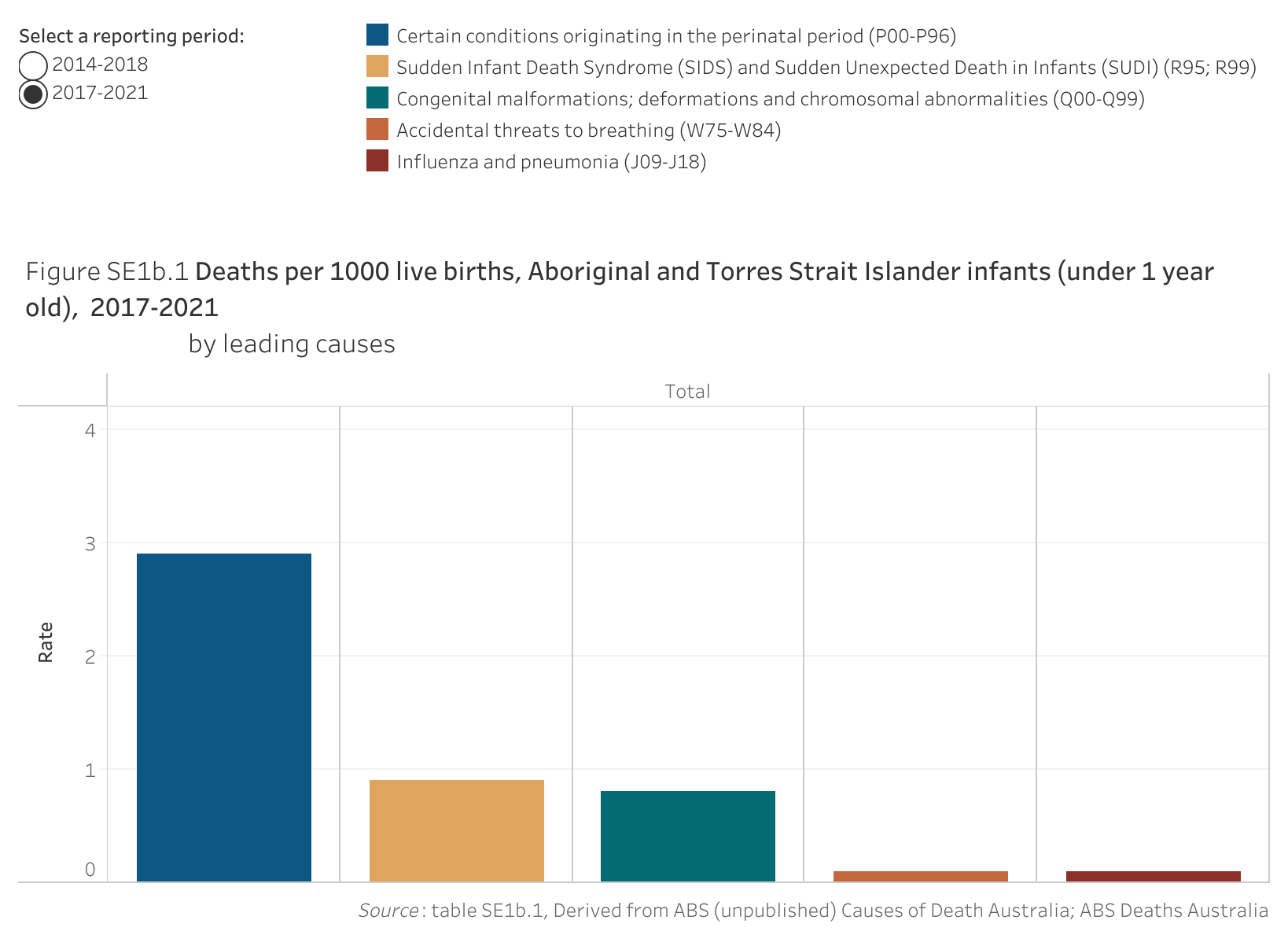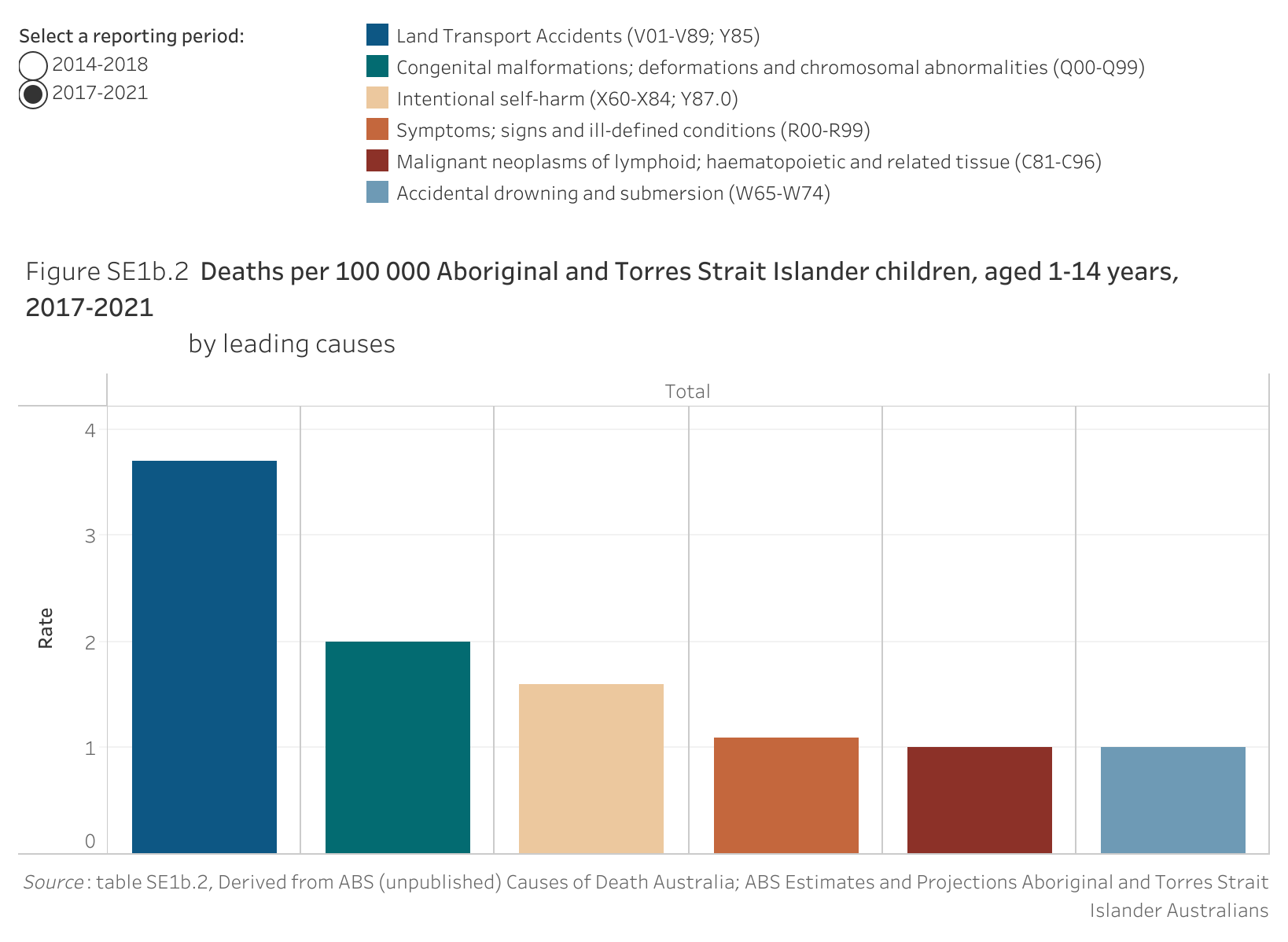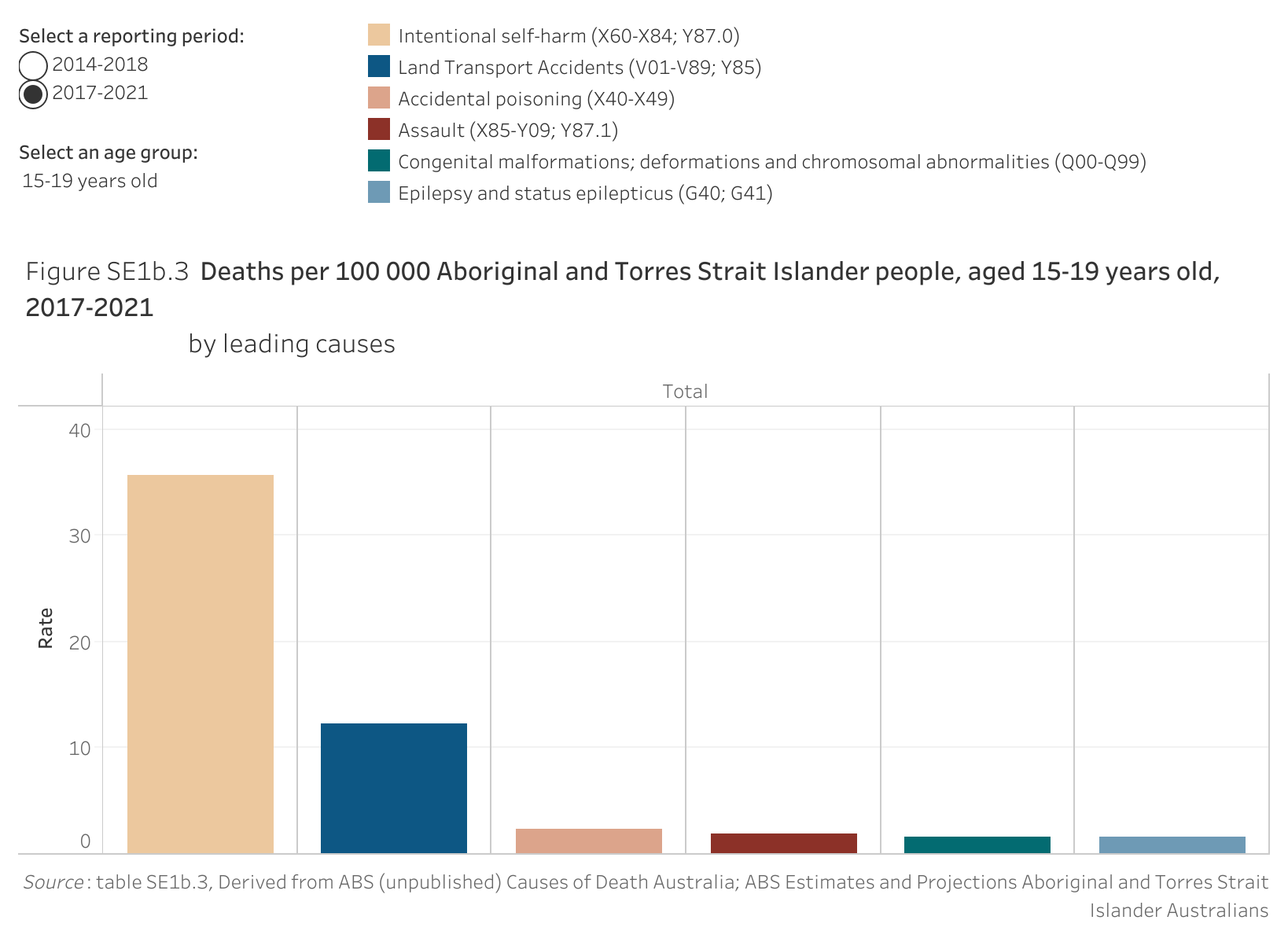Driver
Leading causes of death
Infant mortality, child mortality, and five-yearly age groups
Dashboard snapshot: The data below are the most recent at the time of preparing the July 2023 report. Please go to the dashboard to access the current data.
Measure 1
Infant mortality rate, by the leading causes of death
Nationally in 2017-2021, the leading cause of death for Aboriginal and Torres Strait Islander infants (aged under 1 year) was certain conditions originating in the perinatal period (2.9 per 1000 live births) (figure SE1b.1).
Between 2014-2018 and 2017-2021, this rate decreased (from 3.4 per 1000 live births). The rates for all other leading causes remain under 1.0 per 1000 live births.

| Description4 | 2017-2021 |
|---|---|
| Certain conditions originating in the perinatal period (P00-P96) | 2.9 |
| Sudden Infant Death Syndrome (SIDS) and Sudden Unexpected Death in Infants (SUDI) (R95; R99) | 0.9 |
| Congenital malformations; deformations and chromosomal abnormalities (Q00-Q99) | 0.8 |
| Accidental threats to breathing (W75-W84) | 0.1 |
| Influenza and pneumonia (J09-J18) | 0.1 |
Measure 2
Child mortality rate, by the leading causes of death
Nationally in 2017-2021, the leading cause of death for Aboriginal and Torres Strait Islander children (aged 1 to 14 years) was land transport accidents (3.7 per 100 000 children) (figure SE1b.2).
This is similar to the rate in 2014-2018 (3.6 per 100 000 children). The rates for all other leading causes remain 2.0 or less per 100 000 children.

| Description4 | 2017-2021 |
|---|---|
| Land Transport Accidents (V01-V89; Y85) | 3.7 |
| Congenital malformations; deformations and chromosomal abnormalities (Q00-Q99) | 2.0 |
| Intentional self-harm (X60-X84; Y87.0) | 1.6 |
| Symptoms; signs and ill-defined conditions (R00-R99) | 1.1 |
| Malignant neoplasms of lymphoid; haematopoietic and related tissue (C81-C96) | 1.0 |
| Accidental drowning and submersion (W65-W74) | 1.0 |
Measure 3
Mortality rate, by the leading causes of death
For Aboriginal and Torres Strait Islander people in younger age groups (5-year age groups from 15 to 39 years) the leading cause of death is intentional self-harm. From 2014-2018 to 2017-2021, the rate of deaths due to intentional self-harm decreased for Aboriginal and Torres Strait Islander people aged in their 30’s, but increased for those aged 15-29 years (figure SE1b.3).
From 40 to 74 years of age (5-year age groups) the leading cause of death for Aboriginal and Torres Strait Islander people is ischemic heart disease. From 2014-2018 to 2017-2021, these rates have decreased with the exception of those aged 45-54 years.
For Aboriginal and Torres Strait Islander people aged 75 years or over, dementia has overtaken ischemic heart disease as the leading cause of death (in 2017-2021 compared to 2014-2018).

| Description4 | 2017-2021 |
|---|---|
| Intentional self-harm (X60-X84; Y87.0) | 35.7 |
| Land Transport Accidents (V01-V89; Y85) | 12.3 |
| Accidental poisoning (X40-X49) | 2.4 |
| Assault (X85-Y09; Y87.1) | 1.9 |
| Congenital malformations; deformations and chromosomal abnormalities (Q00-Q99) | 1.6 |
| Epilepsy and status epilepticus (G40; G41) | 1.6 |
Indicator data specifications
Related Outcome: | Aboriginal and Torres Strait Islander people enjoy long and healthy lives. |
|---|---|
Related target: | Close the Gap in life expectancy within a generation, by 2031. |
Indicator: | Leading causes of death (infant mortality, child mortality, and five-yearly age groups) |
Measures: | There are three measures for this indicator. Measure 1 is the infant mortality rate (for persons aged less than one year), by the leading causes of death and total, defined as: Numerator — number of deaths for Aboriginal and Torres Strait Islander children aged less than one year, by ICD-10 cause groups Denominator — number of Aboriginal and Torres Strait Islander live births and is presented as a rate per 1000 live births. Measure 2 is the child mortality rate (for persons aged 1 to 14 years), by the leading causes of death and total, defined as: Numerator — number of deaths for Aboriginal and Torres Strait Islander children aged 1 to 14 years, by ICD-10 cause groups Denominator — number of Aboriginal and Torres Strait Islander children aged 1-14 years and is presented as a rate per 100,000 population. Measure 3 is the mortality rate, for persons aged 15 years or over, by the leading causes of death and total, by age group (five-year age groups for ages 15-74 years, and 75 years or over), defined as: Numerator — number of deaths for Aboriginal and Torres Strait Islander people, by age group, by ICD-10 cause groups Denominator — number of Aboriginal and Torres Strait Islander people, by age group and is presented as a rate per 100,000 population. |
Indicator established: | National Agreement on Closing the Gap July 2020 |
Latest dashboard update for the indicator: | 15 June 2023 |
Indicator type: | Driver |
Interpretation of change: | For all measures, a decreasing rate is desirable. |
Data source(s): | Numerator (all measures) Name: ABS Causes of Death Collection Frequency: Annual Documentation (links): https://www.abs.gov.au/statistics/health/causes-death/causes-death-australia/ Denominator (measure 1) Name: Births Australia Frequency: Annual Documentation: https://www.abs.gov.au/statistics/people/population/births-australia Denominator (measures 2 and 3) Name: Estimates and projections for Aboriginal and Torres Strait Islander Australians Frequency: Annual (data revised on a five-yearly basis) |
Data provider: | Provider name: Australian Bureau of Statistics Provider area: Health and Vitals (numerator); Demography (denominators) |
Baseline year: | 2014-2018 (five year aggregate) |
Latest reporting period | 2017-2021 (five year aggregate) |
Disaggregations: | Infants (Children under 1 year) by the leading causes of death (and total) and all cause total, by years (five years combined) by selected states and territories (and total, by Indigenous status Children 1-14 years by the leading causes of death (and total) and all cause total, by years (five years combined), by selected states and territories (and total), by Indigenous status People aged 15 years or over by age group (5-year age groups and 75 years or over), by the leading causes of death (and total) and all cause total, by years (five years combined), by selected states and territories (and total), by Indigenous status |
Computation: | Measure 1: Numerator divided by Denominator multiplied by 1000. Rates use the total of the five years for numerator and total of five years for denominator. Measures 2 and 3: Numerator divided by Denominator multiplied by 100 000. Rates use the total of the five years for numerator and total of five years for denominator. Data are provided for non-overlapping time periods, other than for the latest reporting period. Counting rules Numerator (all measures) Aggregate number of deaths, over the five year time period. Reporting is only for those jurisdictions which have adequate levels of Indigenous identification (NSW, Queensland, WA, SA and the NT from 1998). Excludes deaths where Indigenous status was not stated. From 2016, deaths with not stated age have not been prorated and are excluded from analysis. Data are presented for the underlying cause of death according to the International Statistical Classification of Diseases and Related Health Problems, Tenth Revision (ICD-10). The World Health Organisation (WHO) defines the underlying cause of death as the disease or injury that initiated the train of morbid events leading directly to death. Data are provided for the ‘leading causes of death’ based on the WHO recommended tabulation of leading causes, For further information see: https://www.abs.gov.au/methodologies/causes-death-australia-methodology/2021#mortality-tabulations-and-methodologies Where possible, the leading causes of death are presented as the top five cause groups listed from highest to lowest Indigenous rate, for each age group, for the most recent period (5 years combined). A top six is presented if there are equal number of deaths for the causes listed as the fifth leading cause of death. Less than top 5 causes may be listed if there are only a small number of deaths against some of the causes. The leading causes of death need to be re-assessed each reporting period. If a change is identified, data may need to be backcast to the baseline year for the most recent set of leading causes to ensure a consistent time series. Denominator (measure 1)
Denominator (measures 2 and 3)
|
Data quality considerations: | Data are presented in five year groupings due to volatility of the small numbers involved. From 2014, cells with small values have been randomly adjusted to protect confidentiality. Some totals will not equal the sum of their components. Cells with a zero value have not been adjusted. Mortality rates based on a small numbers of deaths may volatile between reference periods. Age-specific death rates based on a very low death count have not been published, and appear as 'np'. Age-specific death rates based on a number of deaths below 10 should be treated with caution. Mortality rates by Indigenous status are produced for NSW, Queensland, WA, SA and the NT only. Aboriginal and Torres Strait Islander mortality rates are not produced for Victoria, Tasmania and the ACT due to the small number of Aboriginal and Torres Strait Islander deaths reported in these jurisdictions. Caution is required when interpreting trends in mortality rates, because of changes in Indigenous identification across data collection and over time, and variation across geographies and socioeconomic groups. Although most deaths of Aboriginal and Torres Strait Islander people are registered, it is likely that some are not accurately identified as Aboriginal and Torres Strait Islander people. Therefore, these data are likely to underestimate the Aboriginal and Torres Strait Islander mortality rates. |
Future reporting: | Additional disaggregations required for future reporting:
|
